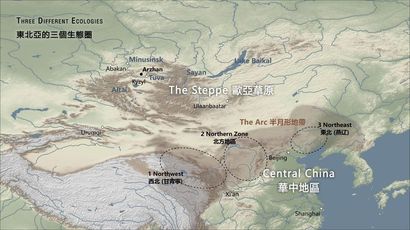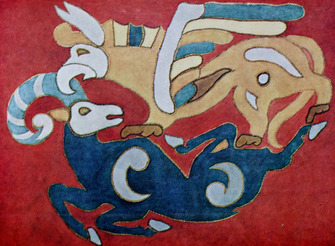China in Eurasien (bis zum Beginn der Kaiserzeit)
Haupt- bzw. Oberseminar (MA)
von Prof. Dr. Jessica Rawson (Oxford) und Prof. Dr. Maria Khayutina (LMU München)
Dienstag 12-14 Uhr
Der Kurs richtet sich auf Masterstudierende aller altertumswissenschaftlicher Fächer. Auch interessierte und Doktorandinnen sind herzlich willkommen. Arbeitssprachen sind Englisch und Deutsch. Bei regelmäßiger Teilnahme nach dem Vorlegen einer Hausarbeit bzw. Thesenpapiers können MA-Studierende ECTS Punkte entsprechend jeweiligen MA-Studienordnungen erwerben.
Kursformat
Der Unterricht findet in Präsenz am Institut für Sinologie statt. Die Teilnehmerzahl ist auf 14 Personen begrenzt. Bewerbungen mit einem kurzen Motivationsschreiben und Angaben zum Fach und Status werden per E-Mail an Maria.Khayutina@lmu.de bis zum 20. April erwartet.
Von insgesamt 13 Sitzungen (s. den vorläufigen Veranstaltungsplan unten) werden zwei Seminare am Anfang und am Ende des Semesters von Prof. Jessica Rawson unterrichtet. In zehn Sitzungen dazwischen wird aktuelle Forschungsliteratur gelesen und diskutiert. Einzelne Aspekte werden von TeilnehmerInnen in Referaten präsentiert. Diese Sitzungen werden von Prof. Maria Khayutina geleitet. In der Semestermitte wird ein hybrides Treffen mit Prof. Rawson online und Prof. Khayutina vor Ort stattfinden, auf welchem gesammelte Fragen von TeilnehmerInnen sowie methodologische Aspekte der interdisziplinären Forschung diskutiert werden.
Kursschwerpunkt
Das antike China war eine lange Zeit von Historikern als eine isolierte, sich ohne Einflüsse von außen herausgebildete, Zivilisation betrachtet. Die Kommunikation mit der Außenwelt schien erst mit der Eröffnung der sog. „Seidenstraßen“ etwa im 2.-1. Jh. v.u.Z. zu beginnen. Archäologische Forschung insb. der letzten ca. 50 Jahren lieferte zahlreiche Hinweise darauf, dass die Geschichte der überregionalen Austauschbeziehungen im Raum zwischen dem Gelben und etwa dem Schwarzen Meeren tatsächlich rund zwei Jahrtausende länger zählt und dass die chinesische Zivilisation vielfältige Impulse von außen empfing, die sie teils adoptierte bzw. adaptierte und teils abstieß. Deutlich wird dabei auch die wichtige Vermittlungsrolle von mobilen Bevölkerungsgruppen, welche im eurasiatischen Steppengürtel verkehrten. Die Erforschung von überregionalen Kontakten ist allerdings alles andere als einfach, denn relevante Fundorte liegen heute auf Territorien mehrerer Staaten mit unterschiedlichen wissenschaftlichen Traditionen und Wissenschaftssprachen. Die wissenschaftliche Arbeit wird zudem häufig durch inner- und außenpolitische Umstände erschwert. Die Quellenvielfalt erfordert die Zusammenarbeit von „klassischen“ Archäologen mit Vertretern neuerer Wissenschaftszweige, wie Archäobotanik, Archäozoologie, Archäometallurgie und weitere archäometrische Disziplinen. Auch Historiker müssen prüfen, welches Licht die neuen Ergebnisse auf das Verständnis von schriftlichen Quellen werfen. Dennoch ist der hohe Arbeitsaufwand durch die große Bedeutung der Erkenntnisse für die Kulturgeschichte unseres Kontinents gerechtfertigt. In diesem Kurs streben wir an, den aktuellen Forschungsstand über die Geografie und Formen von überregionalen Kontakten im Osten Eurasiens während der Bronzezeit und der Eisenzeit zu überblicken, methodische Herangehensweisen mehrerer beteiligten Disziplinen kennenzulernen und verschiedene theoretische Interpretationen kritisch zu bewerten.
Seminare von Prof. Rawson
Seminar 1.: Geographic and environmental settings and main interaction channels. Horses, herded animals and metallurgy.

The seminar will consider the overall geography, environment and climate. The major divisions of China, the supposedly central middle and lower Yellow River basin facing two geographical challenges in spreading what we might call a Chinese culture, namely the huge Yangtze River and its several rather separate basins and to the north, a large area, the Arc (Tong Enzheng’s crescent-shaped region), covered in loess. This was an essential buffer area between the Yellow River basin and the broader Eurasian steppe.
The Eurasian steppe is geologically a separate region. In the east, Mongolia especially is very high and leaves little archaeologically above ground, due to severe errosion. But a massive horse culture has left major monuments, the kirigsuurs and deerstones. A key hinge is the Altai-Sayan range, with its minerals, and the connections with the mountain-corridor, all the way to the Hindu Kush. Western Siberia connects with Mesopotamia and Anatolia.
The seminar will also consider the introduction of herded animals, sheep and cattle, followed by metallurgy and then horses into northern China along the steppe and mountain corridors and the consequences of these late arrivals into a highly developed society. This discussion will introduce the sites of Taosi and Shimao and outline ways to identify introductions from the steppe into China.
Seminar 2: Steppe kurgans and mounded burials in eastern China as evidence of interactions and steps towards the formation of the Silk Roads

This seminar will use the tomb of Lord Bai of Zhongli at Bengbu to discuss the introduction of steppe materials and tomb building features especially stone to central China. The tomb of Lord bai with that of his spouse and son are unique. These are the only circular tombs in China. Lord Bai’s tomb also has other unusual features, most especially, a terrace above the main burial area. A large ramp could take people down to the terrace and to small staircases onto the terrace. A large wall of imitation boulders made of earth or clay lined the outer edge of the terrace. This and other features of the tomb can be traced to the steppe kurgans, most especially Arzhan 2 in the Tuva Republic of the Russian Federation.
The seminar will discuss ways to track this contact, drawing attention to a long line of communication along the eastern seaboard. In parallel movement south in the Loess Plateau brought material such as gold, iron and swords south also. These exchanges were a further step towards the development of the Silk Road. Although a period of occupation and development of both the east and the Arc took Zhou practices into many areas, in the longer run this ‘colonisation’, especially of the north, put the whole of northern China into direct contact with the steppe. This was to have a long-term impact on China as a whole.
Downloads
- Seminar_Rawson-Khayutina (148 KByte)

